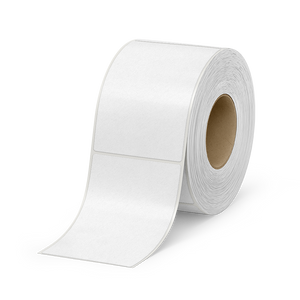Thermal Transfer Labels for Manufacturing: Durable, Reliable, and Precise

If you’ve ever had a label fall off a bin mid-shift, fade out before it gets scanned, or smear the moment it hits heat—then you already know the importance of choosing the right label.
For manufacturers, thermal transfer labels—especially those made from polyester—aren’t just durable, they’re dependable in all the ways that count. This is about labeling that sticks, scans, and stays readable long after the job’s done.
Why Thermal Transfer Labels Are the Industry Workhorse
Thermal transfer printing uses a heat-based process to bond the image—often a barcode or critical data—directly onto the label surface via a ribbon. It’s this method that makes the print:
- Sharp and scannable
- Resistant to smudges and fading
- Capable of lasting months—or years
In a manufacturing environment where parts move, get cleaned, or sit in storage under rough conditions, this reliability isn’t optional—it’s essential.

Why Polyester Is the Label Material That Doesn’t Quit
Paper labels can’t survive the floor. They tear, smear, and peel. Polyester thermal transfer labels, though? Built differently. They hold strong against:
- High temperatures (think ovens, weld zones, and machine housings)
- Abrasion from metal-to-metal contact or constant handling
- Solvents, oils, degreasers, and other harsh chemicals
- UV and outdoor exposure for long-term labeling
Whether you’re tagging parts on a powder coating line, applying compliance labels to electrical panels, or tracking tools across multiple workstations, polyester won’t flinch.
Tip: Pair with a resin ribbon for best results. The combo gives you crisp barcodes and ultra-durable images that hold up—even after cleaning or extreme exposure.
![]()
Where These Labels Show Up on the Floor (And Why)
Here’s how manufacturers put polyester thermal transfer labels to use day in and day out:
Inventory Bins
Polyester barcode labels help workers scan quickly, even if bins are stacked, moved, or exposed to dirt and grease.
Tool and Asset Tagging
Labels stay intact on hand tools, machines, carts, or lift equipment. They hold firm through maintenance and movement.
Work-in-Progress Tracking
Label components or subassemblies at each station—no matter how many hands they pass through, the barcode holds.
Safety and Compliance
Need a label to stay readable for audits, inspections, or certification tagging? This is what polyester was made for.
Tips for Getting It Right the First Time
A good label isn’t just about the material. Here’s what else makes a difference:
- Use the right adhesive: For oily, dusty, or curved surfaces, go with high-tack options designed for rough environments.
- Don’t skip ribbon testing: Resin ribbons cost more than wax—but they’re the only way to make polyester labels live up to their potential.
- Keep surfaces clean before application: Even the best labels can’t fight off grime during placement.
- Avoid placing in high-wear zones: If something constantly rubs against the label, it’s going to wear. Find a better placement spot when possible.
Why Direct Thermal Isn’t Built for This
Let’s be real—direct thermal labels are fine for short-term use or quick shipping. But for long-term traceability, high heat, or harsh chemicals, they just don’t hold up. They fade, darken, and peel—especially in the kind of industrial environments where time and wear are guaranteed. Thermal transfer labels with polyester are what you use when the work’s not stopping anytime soon.
Your Label Is Only as Good as Its Last Scan
When labels fail, someone has to relabel. Or worse, reprint. That’s time your team doesn’t have. Polyester thermal transfer labels are how you label once, and move on—with the confidence that it’ll still scan tomorrow, next week, or next year. If you’re tired of reapplying, relabeling, or dealing with unreadable barcodes, check out our lineup of thermal transfer labels. They’re built for the kind of work where clarity, durability, and staying power matter.
Frequently Asked Questions
Why are polyester thermal transfer labels better for manufacturing?
They’re durable, chemical-resistant, heat-tolerant, and hold print integrity under tough conditions. They also last longer and scan cleaner than paper or direct thermal labels.
What printer and ribbon should I use for polyester labels?
Use a thermal transfer printer with a resin ribbon. That combination ensures the print bonds tightly to the polyester surface and resists fading or smudging.
Do polyester labels work on oily or curved surfaces?
Yes—with the right adhesive. Look for high-tack adhesives made for industrial settings and prep surfaces before applying for the best stick.
Can polyester labels survive industrial cleaners?
Absolutely. With the right ribbon and material pairing, they resist degreasers, alcohol wipes, water, and even light solvents.
How long do polyester thermal transfer labels typically last?
With proper application and materials, polyester thermal transfer labels can last for years—through multiple shifts, cleanings, and handling cycles.











